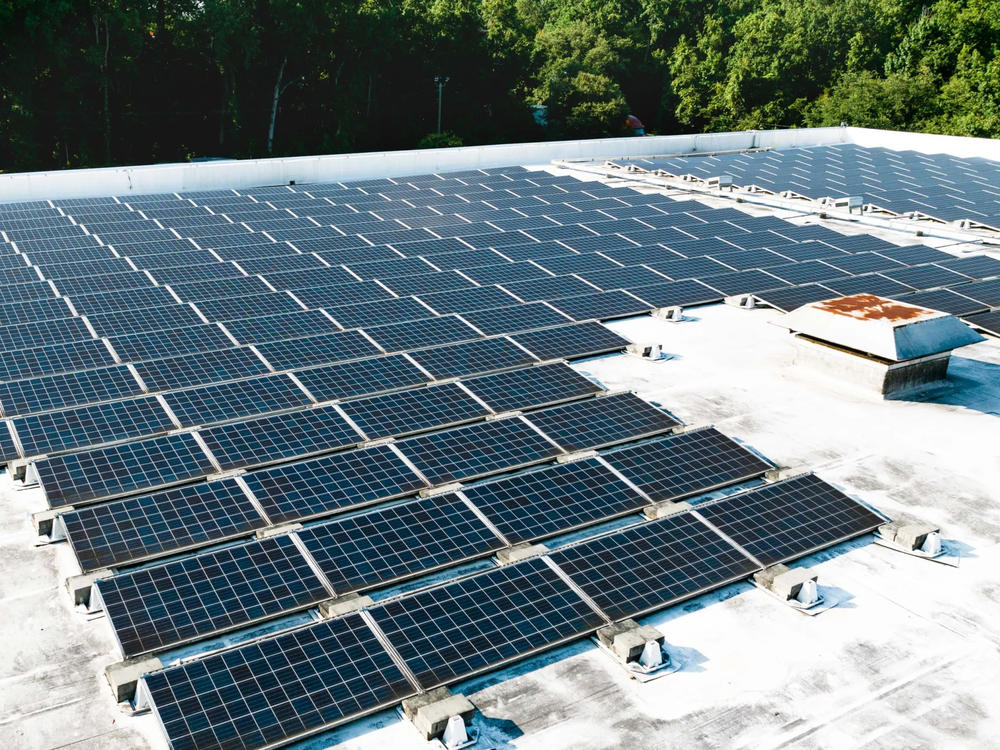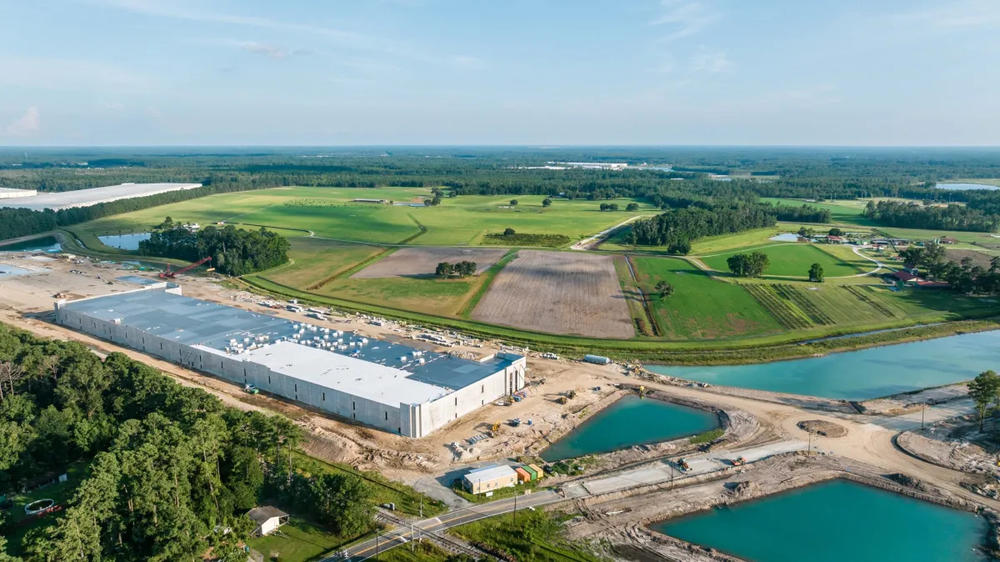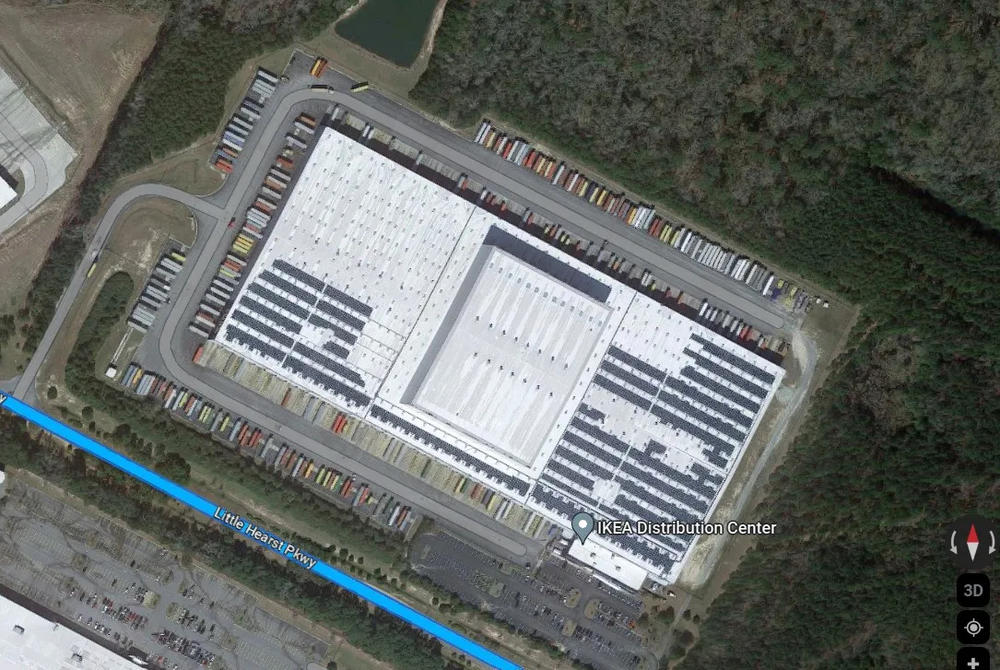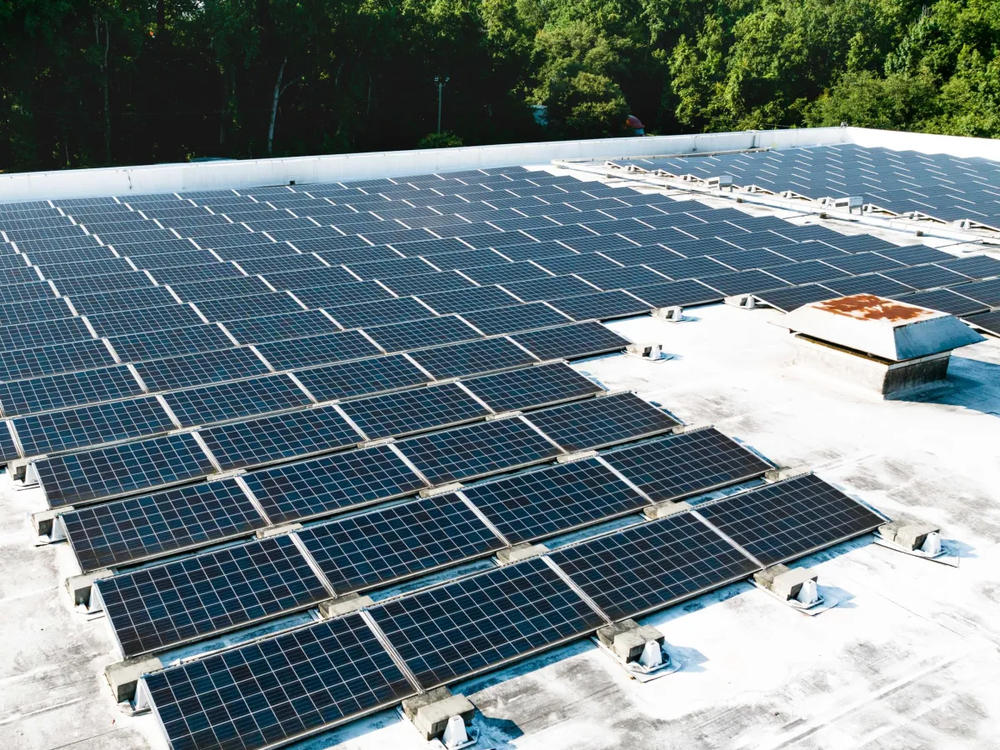
Section Branding
Header Content
Why don’t Coastal Georgia warehouses have solar on their roofs?
Primary Content

Mary Landers, The Current
Coastal Georgia boasts an abundance of sunshine and a rapidly growing abundance of warehouses. But rarely do these two combine to produce electricity from rooftop solar.
There’s so few solar arrays on warehouses here, in fact, that when the nonprofit Environment America produced a report last spring extolling the benefits of what it deemed a “no brainer” placement of solar panels atop warehouses, the statewide affiliate, Environment Georgia, didn’t participate in the launch.
“I didn’t actually send it out because I couldn’t find a really good example,” said Jennette Gayer, the Georgia state director.
That’s in a state that ranks 7th for solar installations overall and 5th for the total area of solar-suitable warehouse roofs.

As it often does, the answer to this seeming mystery comes down to cold hard cash. It’s cheaper for industry to buy electricity off the grid, Gayer said.
“A lot of times these guys pay very low electricity rates,” she said. “Commercial industrial entities negotiate rates at the Public Service Commission and do a great job. The electricity is so cheap that it makes it a little harder for solar to pencil, especially when you think about the fact that we don’t have great incentives for rooftop solar in Georgia.”
Georgia offers no specific state incentives for warehouse solar. State Rep. Mandisha Thomas, a Democrat from South Fulton County, earlier this year introduced HB 536that proposed a tax credit of up to $250,000 for warehouse solar. The bill did not advance to a vote.
Other states that do have incentives provide models that Georgia could look to, especially as it begins to grapple with unintended consequences of solar on farm and forest land.
And while most Georgia warehouses forgo solar panels, at least two companies — one international and one Georgia-based — have embraced it for reasons that go beyond finances.
Where does solar work?
The public loves the idea of solar on rooftops, said Johanna Neumann Senior Director, Campaign for 100% Renewable Energy at Environment America and a co-author of the warehouse report.
“Survey after survey confirms that people like solar; it’s the most popular form of energy out there,” Neumann said. “But they prefer it to be directed to the built environment, like existing rooftops, or existing parking lots, or brownfield sites and to only have solar go to undeveloped land, like forests or farmland, if those other options have been maxed out.”
Most of Georgia’s more than 5,000 megawatts of solar capacity is on the ground, not on rooftops. It’s led to some problems. A federal jury in May awarded a Lumpkin-area couple $135.5 million for damages to their property from a nearby solar farm built without adequate erosion and sediment controls. The Environmental Protection Division is updating its best practices to head off these issues in the future, officials recently told state legislators. They expect to see 50,000 – 100,000 acres disturbed for solar in the next five years.
“We are a top 10 state for utility scale solar,” Gayer said. “And what that means is we’re turning a lot of forest lands into solar fields. And I wish we would take more advantage of our rooftops. And there’s growing concern about some of the runoff issues with all that utility scale solar. And the fact is, we have all these roofs that would be perfect.”
But warehouse owners aren’t necessarily in sync with the public.
“Many owners of warehouses just think about their roofs as structures to keep the weather out,” Neumann said. “And they have not actually wrapped their heads around the energy production potential of that area. So the first thing is actually warehouse owners embracing the idea that their buildings can be energy generators.”
It’s also the case that some warehouse owners are far removed from monthly electric bills.
“They lease those buildings out,” said Rackley Davis of Charleston-based Live Oak Energy Systems, which installs commercial and residential solar across the Southeast. “And the owner of the building does not pay the power bill, so they could care less if their power bills are high. You really need to own the building to put solar on it. I mean, you don’t have to, but it only makes sense. If a company puts a million dollar system on the roof, and then decides to end their lease in five years and move out, are they gonna take that million dollar system down and take it somewhere else? It’s gonna cost a fortune to do that.”
Two Coastal Georgia examples of warehouse solar are both owner/operators. IKEA, the Swedish home furnishings giant installed more than 6,000 solar panels on its distribution center in Port Wentworth in 2012. At the time, IKEA’s roof hosted the state’s largest private solar rooftop array, producing enough electricity to power 170 homes annually.
Rooftop solar is a large part of IKEA’s corporate sustainability goals.

“It is a great point of pride for our on-site coworkers and management team, as it is heavily linked to our sustainability goals,” IKEA U.S. Engineering Manager Adrian Avino wrote in an email.
The company is aiming for 100% renewable electricity for its stores by the 2025 fiscal year. Last year IKEA reported it had increased its renewable electricity share for IKEA retail and other operations to 76% compared to 71% in FY21.
“The PV panels offset approximately 50% of the total energy consumption of the building and have worked well,” Avino wrote of the Port Wentworth installation.
Also in Chatham County, Savannah-based beverage company Savannah Distributing Company topped its 52,000-square-foot warehouse on West Gwinnett Street with 342 solar panels in 2016. With a keg cooler room and a temperature-controlled room for beer and wine, the warehouse has more electricity needs than most warehouses its size.
Vice president and chief operating officer Chris Peters expects the panels to pay for themselves over the next year or so. But as with IKEA, Peters cites sustainability as a reason to install the panels, which are a point of pride for the privately held company.

Savannah Distributing Company plans to install solar on a new warehouse it’s building at its Savannah location next year and also at its Atlanta warehouse, but not right away. Rising construction costs mean the company has less capital to spare at the moment.
“In order to really make that solar work, you’ve got to have capital on the front end to install it,” Peters said.
But it’s just a delay.
“I think once we get this warehouse built and then we can save up some more capital we would definitely do it because I’m seeing over 50% reduction on my energy bills from solar,” Peters said.
What makes warehouse solar shine
Solar isn’t the best fit for every warehouse roof, said Dan King, CEO of California-based Clarity Roof Consulting, which works nationwide. But he will recommend it in some scenarios. High on his list of considerations is the price of electricity.
If electrical costs are high and the owner has a tight cash flow, solar makes more sense, he said. Especially if the warehouse needs a new roof anyway so he can sync the timing of the solar array and the commercial roof, each of which last about 25 years.
Clarity hasn’t recommended any solar roofs in Georgia, where electricity is cheap for large businesses like warehouses. The federal Energy Information Administration reported that in June, the most recent months for which rates were available, industrial rates in Georgia averaged 7.01 cents per kilowatt hour. That’s far less than states like California (19.37 cents) or New Jersey (13.60 cents) where Clarity is more likely to recommend solar.
Clarity is also more skittish about rooftop solar in Georgia for a reason that blew through in late August: hurricanes.
“When we’re in a hurricane zone we typically see solar as more of a risk on the roof,” King said.
Racks of solar panels are typically attached to the roof by anchoring them into the building’s frame through thousands of penetrations through the roof. A hurricane’s winds can lift up the racks, loosening those attachments and creating the potential for leaks, he said.
“Hurricane zones are not a ‘no’ in and of themselves but it requires more due diligence and maintenance of sealants (around the penetrations) to keep them from where they’re drying out and can’t keep up with the movement,” King said.
Logistics company Prologis offers a case study in where warehouse solar makes the most sense for companies. Based in California, Prologis claims to have the largest global portfolio of logistics real estate. It’s also a big player in warehouse solar.
“Prologis has been installing solar on rooftops since 2005. In 2012, we had 83 megawatts of solar rooftops; today we have 450 megawatts throughout our portfolio,” wrote Scott Peattie, Prologis vice president of commercial and industrial energy solutions. “In fact, we are now the second largest generator of corporate on-site solar (behind Target and ahead of Walmart).”
But none of Prologis’ 40 million square feet of warehouse space in Georgia, including 26 properties in the Savannah area, has solar panels on the roof. Nor does it have any in South Carolina or Florida.
All three are states where sunshine is plentiful. But other factors Prologis considers, notably the price of electricity and utility interconnection rules, weigh against rooftop solar in all three.
In fact, Georgia received a grade of F for utility interconnection policies in a June report produced by the Interstate Renewable Energy Council (IREC) and Vote Solar. That report defines interconnection policies as those that “specify the processes, timelines, costs, and technical requirements associated with connecting distributed energy resources (DERs) —such as solar and energy storage systems — safely and reliably to the grid.”
Georgia was among the 13 states that have not adopted statewide interconnection procedures and thus received F grades, along with including Alabama, Alaska, Arkansas, Idaho, Kansas, Louisiana, Missouri, Nebraska, North Dakota, Oklahoma, Tennessee, and Wyoming.
Prologis has focused its solar in California, Indiana, Maryland, New Jersey, New York, Oregon, Virginia and Washington. It also has solar on some of its global properties in Europe, Asia and Latin America.
“Worldwide, our average solar system size is 1.25 MWs; in the U.S., the average size is 1.57 MWs,” Peattie wrote. “While we don’t have a goal for 2023, we have a goal of having 1 gigawatts of solar, supported by storage, by 2025. We are well on the way to achieving, if not surpassing, that goal.”
The other big warehouse solar players that Peattie cited, Walmart and Target, can’t point to rooftop projects in Coastal Georgia, either.
“Our distribution center in Midway, Georgia, does not currently have solar panels, though a number of Target properties do,” wrote Target spokesman Brian Harper-Tibaldo.
That 1.5 million square foot distribution opened in 2007.
Walmart, which aims to be powered by 100% renewable energy by 2035 — operates a distribution center in Savannah. But there’s no solar on its roof.
“We don’t have any onsite solar in Georgia and continue to review every project on a broad range of factors including cost and resource availability — with some of our recent progress coming from investing in various renewable options, including community solar projects and utility-scale wind and solar energy,” spokesman Brian K. Little wrote in an email.
In 2020 renewable sources contributed 36% of Walmart’s global electricity needs. Since 2008, the company is responsible for bringing more than three gigawatts of new renewable energy capacity to the grid. Solar also plays a part in Walmart’s renewable energy power. In 2019, Walmart added the most solar of any company in the U.S.
What New Jersey has that Georgia doesn’t
Warehouses in New Jersey are more likely than those in Georgia to deploy solar on their roofs.
“My understanding is that when it comes to warehouse solar, New Jersey is leading the way, in large part because there is a company there called Solar Landscapes that has really taken advantage of the community solar programs to partner warehouse installations with the surrounding community,” Neumann of Environment America said.
Over the last two years, New Jersey has fostered a robust pilot program for community solar, a model in which solar facilities are shared by community subscribers who receive credit on their electricity bills for their share of the power produced. The pilot program in New Jersey produced 29 solar projects to date with another 97 expected to come online in the near future. On Aug. 16 the state’s Board of Public Utilities voted to make the pilot a permanent program.
New Jersey doesn’t allow community solar on farm or forestland, instead designating it for “rooftops, carports and canopies over impervious surfaces, contaminated sites and landfills, and certain bodies of water such as water treatment reservoirs and dredge ponds.”
Shaun Keegan, CEO and co-founder of Solar Landscape, said warehouse solar offers a wide range of benefits.

“As opposed to rural or ground-mount solar, community solar on commercial rooftops makes our grid more efficient by placing panels closer to the people, and it creates other benefits like jobs in our communities,” he said. “Putting solar on out-of-sight commercial rooftops is smart policy that benefits nearby residents who might not have any other way to go solar, both lowering their energy costs and helping make the local air cleaner.”
Solar Landscape describes the community solar on warehouses as a triple win. The environment benefits from carbon-free energy that preserves open space. The warehouse owner benefits from the income derived from renting their roof for panels. And the neighboring community benefits from electricity, usually available at a discount.
Rules for community solar vary by state and are governed by state public utility commissions like Georgia’s Public Service Commission.
Georgia Power offers community solar, but its three projects are each on ground-mounted arrays. They’re aimed at customers who want to protect the environment, not their pocketbook, said Bryan Jacobs of the Southern Alliance for Clean Energy. Customers pay a premium for it.
“It’s not structured to where people who enroll in the program will save money,” Jacobs said. They don’t promote it that way. They say, this is more for you to do to satisfy your personal objectives to get access to more clean energy.”
Neumann wants to see more state policies to encourage warehouse solar.
“And our hope is that just by elevating this solution, we can get more warehouse owners to start to think about tapping that clean energy potential of their roofs,” she said. “I will say there are a number of warehouse owners who are starting to think about this.”
This story comes to GPB through a reporting partnership with The Current.

